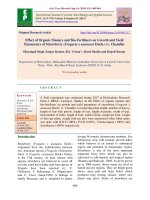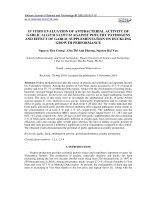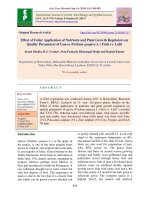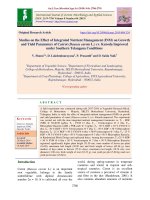Evaluation of post emergence herbicides on growth parameters of finger millet
Bạn đang xem bản rút gọn của tài liệu. Xem và tải ngay bản đầy đủ của tài liệu tại đây (398.61 KB, 9 trang )
Int.J.Curr.Microbiol.App.Sci (2018) 7(3): 1126-1134
International Journal of Current Microbiology and Applied Sciences
ISSN: 2319-7706 Volume 7 Number 03 (2018)
Journal homepage:
Original Research Article
/>
Evaluation of Post Emergence Herbicides on Growth
Parameters of Finger Millet
Srishti Pandey*, H.L. Sonboir and Damini Thawait
Department of Agronomy, College of Agriculture, Raipur, Chhattisgarh, India
*Corresponding author
ABSTRACT
Keywords
Weed management,
Finger millet
Article Info
Accepted:
10 February 2018
Available Online:
10 March 2018
The production and productivity of finger millet in the country is lower because of weeds
pose one of the major constraints there were thirteen treatments which comprised single
application of different post-emergence herbicides either alone or in combination and hand
weeding was conducted on Clayey Vertisols soil of College of Agriculture, Raipur during
kharif season of 2012. There was no phytotoxicity in finger millet with application of
ethoxysulfuron and metsulfuron methyl + chlorimuron ethyl alone. Significant level of
mortality was recorded with application of fenoxaprop-p-ethyl and cyhalofop- butyl alone
or in combination with other herbicides. The maximum plant height of finger millet was
recorded under the treatment hand weeding twice which was at par with that of
ethoxysulfuron and metsulfuron methyl + chlorimuron ethyl. The highest dry matter
accumulation of finger millet was observed in fenoxaprop-p-ethyl (37.5 g ha-1) +
ethoxysulfuron.
Introduction
Eleusine coracana, or finger millet, is
an annual herbaceous plant widely grown as
a cereal crop in the arid and semiarid areas.
Finger millet is a short-day plant with a
growing optimum twelve hours of daylight for
most varieties. It is generally considered as a
drought tolerant crop. But compared with
other millets, such as pearl millet and sorghum
it prefers moderate rainfall (≥500 mm
annually). The majority of worldwide finger
millet farmers grow it rainfed, although yields
often can be significantly improved when
irrigation is applied. Finger millet can grow on
various soils, including highly weathered
tropical lateritic soils. Furthermore, it can
tolerate soil salinity up to a certain extent. Its
ability to bear water logging is limited,
therefore good drainage of the soils and
moderate water holding capacity are
optimal. Finger millet can tolerate moderately
acidic soils (pH 5) but also moderately
alkaline soils (pH 8.2). Weeds are the major
biotic stresses for finger millet cultivation. Its
seeds are very small, which leads to a
relatively slow development in early growing
stages. This makes finger millet a weak
competitor for light, water and nutrients
compared with weeds. It is used both as
medicinal and traditional purposes. Finger
millet is a high statue crop with slower initial
growth which remains under smothering due
to the infestation of weeds at early stages of
1126
Int.J.Curr.Microbiol.App.Sci (2018) 7(3): 1126-1134
growth. This situation causes higher
competition and may result in drastic
reduction in yield (Kushwaha et al., 2002).
The production and productivity of the
country is lower because of weeds pose one of
the major constraints in the production of
finger millet. Owing to initial slow growth of
the finger millet favours weed growth, which
cause more competition for sunlight, nutrient
and water in early stages of growth lead in
lowering productivity (Kumara et al., 2007).
The critical period of crop weed competition
for the finger millet varies from 25-45 days
after sowing (Lall and Yadav, 1982). Weeds
compete with crop plants for water, nutrients,
space and solar radiations by reduction of
yield upto 20 to 50 per cent. Kushwaha et al.,
(2002) reported that weeds caused an
appreciable reduction in density, dry weight
and depletion of nutrients. Manual weed
management, which is the most prevalent
method for weed management in finger millet,
requires a lot of labour. Now a day, due to the
scarcity of labours, chemical weed
management is considered as better option
than the hand weeding. Chemical weed
management practices might be an answer to
achieve greater weed control efficiency, which
in turn, may increase over all benefit of finger
millet cultivation. The work on effect of post
emergence herbicides in weed management of
finger millet is very limited; therefore,
keeping these points in view the present
investigation was carried out to evaluation of
post-emergence
herbicides
for
weed
management in direct sown finger millet.
Materials and Methods
The present investigation entitled “Evaluation
of post-emergence herbicides for weed
management in direct sown Finger millet.”
was carried out at Instructional cum Research
Farm, Indira Gandhi Krishi Vishwavidyalaya,
Raipur (C.G.) India, during the kharif season
(July-November) 2012. The soil of
experimental field was Clayey (Vertisols),
which was low in nitrogen, medium in
phosphorus and high in potassium contents
with neutral in pH. The experiment was laid
out in randomized block design (RBD) with
three replications. There were thirteen
treatments of post-emergence herbicides along
with two hand weeding and untreated control.
The finger millet cultivar “GPU-28” was sown
and harvested on 11th July, 2012 and 20th
November, 2012 respectively, using seed rate
of 10 kg ha-1 at 25 cm distance and gaps were
maintained by thinning to obtain proper plant
population. Sowing was performed by
manually and crop was fertilized with
60:40:40 N: P2O5:K2O kg ha-1. Half dose of
nitrogen (30 kg/ha) and full dose of P and K
(40 and 20 Kg/ha respectively) were applied
as basal and remaining half of nitrogen (30
kg/ha) was top dressed one month later. Plant
protection measures were followed as per
recommendation.
The treatments were viz. T1- Fenoxaprop-pethyl (37.5 g ha-1), T2- Fenoxaprop-p-ethyl
(45.0 g ha-1), T3- Metsulfuron methyl +
Chlorimuron ethyl, T4- Ethoxysulfuron, T5 –
Cyhalofop-butyl, T6- Fenoxaprop-p-ethyl
(37.5 g ha-1) + metsulfuron methyl +
chlorimuron ethyl, T7- Fenoxaprop-p-ethyl
(45.0 g ha-1) + metsulfuron methyl +
chlorimuron ethyl, T8- Fenoxaprop-p-ethyl
(37.5 g ha-1) + ethoxysulfuron, T9Fenoxaprop-p-ethyl (45.0 g ha-1) +
ethoxysulfuron, T10- Cyhalofop-butyl +
metsulfuron methyl + chlorimuron ethyl, T11Cyhalofop-butyl + ethoxysulfuron, T12- Hand
weeding twice and T13- Weedy check. The
observations were recorded on the growth
parameters, yield attributing characters and
yield of crop to study the effect of weed
management on growth and productivity of
Finger millet. Plant height was measured in
cm from ground surface to the longest plant
part. Plant height and number of tillers plant-1
of five tagged plants in each net plot area was
1127
Int.J.Curr.Microbiol.App.Sci (2018) 7(3): 1126-1134
recorded at an interval of 15, 30, 45, 60, 75
and 90 DAS and at harvest and then average
was worked out and used for statistical
analysis. Dry matter accumulation (g plant-1)
was recorded at 15, 30, 45, 60, 75 and 90 DAS
and at harvest. Five randomly selected plants
were uprooted carefully along with the roots.
Root portion was detached and shoot portion
of the plant was sun dried followed by drying
in hot air oven at 60oC for 48 hours to record
constant dry weight. After drying, the samples
were weighed on an electronic digital balance
and then average was worked out to get dry
matter accumulation plant-1. Net plot area was
not disturbed. The crop was observed for
phytotoxic effect of different herbicides at 7,
14 and 21 days after herbicide application.
The number of live plants was counted from
marked place in one m-2 net plot area. The
mortality of finger millet was calculated as per
following formula:
PPi - PPa
Mortality (%) = ------------------- × 100
PPi
PPi = Plant population before herbicide
application
PPa = Plant population after herbicide
application
These were subjected to arc sine
transformation before statistical analysis.
Results and Discussion
The observation on finger millet viz. plant
height, number of tillers, dry matter
accumulation etc. was significantly influenced
by different weed management practices at
different growth stages, moreover these
parameters at 15 DAS, which is before
imposition of treatments, exhibited nonsignificant variation.
Phytotoxicity: Mortality in finger millet by
application of different herbicide is given in
Table 1 and Figure 1. At 7 days after
application no mortality with application of
ethoxysulfuron and metsulfuron methyl +
chlorimuron ethyl alone.
The highest mortality (55.3 %) was recorded
with application of fenoxaprop-p-ethyl (45.0 g
ha-1) + ethoxysulfuron. At 14 days after
application there was no mortality with
application of ethoxysulfuron and metsulfuron
methyl + chlorimuron ethyl alone.
The highest mortality (60.05 to 62.11 %) was
recorded with application of ethoxysulfuron
combined with fenoxaprop-p-ethyl at both
levels which was statistically similar with each
other. At 21 days after application there was
no
mortality
with
application
of
ethoxysulfuron and metsulfuron methyl +
chlorimuron ethyl alone. The highest mortality
(73.56 to 76.82 %) was recorded with
application of ethoxysulfuron combined with
fenoxaprop-p-ethyl at both levels which was
statistically similar with each other.
In general, plant height increased with the
advancement in age of the crop (Table 2).
Hand weeding twice gave maximum plant
height at 30 DAS. The lowest plant height was
recorded with fenoxaprop-p-ethyl (45.0 g ha-1)
+ metslfuron methyl + chlorimuron ethyl. At
60 DAS Ethoxysulfuron gave the maximum
plant height.
The lowest plant height was observed in
fenoxaprop-p-ethyl (45.0 g ha-1) + metsulfuron
methyl + chlorimuron ethyl. At 90 DAS
ethoxysulfuron gave the highest plant height.
The lowest plant height was found with
application of fenoxaprop-p-ethyl (45.0 g ha1
). At harvest hand weeding twice gave the
highest plant height. The lowest plant height
was observed with the application of
fenoxaprop-p-ethyl (45.0 g ha-1).
1128
Int.J.Curr.Microbiol.App.Sci (2018) 7(3): 1126-1134
Table.1 Plant population and mortality of finger millet by application of different herbicide
Treatment
-1
Dose (g ha )
-2
Plant population m
before spraying
Mortality of plant %
07 DAA
14 DAA
21 DAA
T1 : Fenox
37.5
78
40.45 (42.33)
47.18 (53.57)
63.49 (79.42)
T2 : Fenox
45.0
80
45.95 (51.60)
53.27 (64.11)
67.54 (84.79)
T3 : MSM+CME
2.0+2.0
79
0.00 (0.00)
0.00 (0.00)
0.00 (0.00)
T4 : Ethox
15.0
78
0.00 (0.00)
0.00 (0.00)
0.00 (0.00)
T5 : Cyhalo
62.5
81
22.95 (15.22)
26.75 (20.15)
44.44 (49.14)
T6 : Fenox+MSM+ CME
37.5+2.0+2.0
81
36.65 (35.88)
47.75 (55.18)
66.12 (83.81)
T7 : Fenox+MSM+ CME
45.0+2.0+2.0
82
38.89 (39.20)
42.61 (46.02)
58.56 (71.75)
T8 : Fenox+Ethox
37.5+15.0
80
48.70 (56.83)
60.05 (74.06)
73.56 (91.15)
T9 : Fenox+Ethox
45.0+15.0
82
55.30 (67.79)
62.11 (77.76)
76.82 (94.38)
T10 : Cyhalo+MSM+ CME
62.5+2.0+2.0
80
19.48 (11.15)
24.89 (18.97)
37.16 (36.96)
T11 : Cyhalo+Ethox
62.5+15.0
79
19.07 (10.78)
27.62 (21.58)
41.15 (42.86)
T12 : Weed free (HW at 20 and 40 DAS)
78
0.00 (0.00)
0.00 (0.00)
0.00 (0.00)
T13: Weedy check
80
0.00 (0.00)
0.00 (0.00)
0.00 (0.00)
SEm ±
10.71
1.98
2.62
2.58
CD at 5 %
NS
5.79
7.65
7.55
The observations are arc sine transformed. Figures in parentheses indicate the original value. Fenox = Fenoxaprop-p-ethyl, MSM = Metsulfuron methyl, CME =
Chlorimuron ethyl, Ethox = Ethoxysulfuron, Cyhalo = Cyhalofop–butyl, HW = Hand weeding
1129
Int.J.Curr.Microbiol.App.Sci (2018) 7(3): 1126-1134
Table.2 Plant height of finger millet as influenced by different herbicidal treatments
Treatment
Dose
Plant height (cm)
-1
(g ha )
15 DAS
30 DAS
45 DAS
60 DAS
75 DAS
90 DAS
At harvest
T1 : Fenox
37.5
10.3
18.6
38.5
49.1
75.9
90.1
85.7
T2 : Fenox
45.0
10.2
15.7
35.7
46.3
74.3
84.4
78.2
T3 : MSM+CME
2.0+2.0
11.0
29.0
58.8
63.7
101.8
111.6
101.7
T4 : Ethox
15.0
10.7
29.1
57.3
63.8
97.4
116.7
101.8
T5 : Cyhalo
62.5
10.5
22.0
42.5
52.9
78.0
98.2
88.9
T6 : Fenox+MSM+ CME
37.5+2.0+2.0
10.0
18.1
38.6
50.9
82.4
92.9
87.3
T7 : Fenox+MSM+ CME
45.0+2.0+2.0
10.7
13.7
31.9
43.5
78.0
90.8
82.9
T8 : Fenox+Ethox
37.5+15.0
10.2
16.8
35.3
48.7
79.5
92.8
87.7
T9 : Fenox+Ethox
45.0+15.0
10.2
16.2
33.5
47.1
74.5
96.5
90.5
T10 : Cyhalo+MSM+ CME
62.5+2.0+2.0
10.6
18.5
45.3
47.0
75.1
89.2
82.6
T11 : Cyhalo+Ethox
62.5+15.0
10.3
19.3
41.9
52.2
79.4
96.0
91.9
T12 : Weed free (HW at 20 and 40 DAS)
10.2
32.1
57.6
63.2
96.3
114.3
104.3
T13: Weedy check
10.5
31.6
56.9
63.2
98.3
99.6
92.2
SEm ±
CD at 5 %
1.13
NS
1.69
4.94
3.55
10.36
2.84
8.29
4.40
12.84
3.84
11.23
3.47
10.51
Fenox = Fenoxaprop-p-ethyl, MSM = Metsulfuron methyl, CME = Chlorimuron ethyl, Ethox = Ethoxysulfuron, Cyhalo = Cyhalofop–butyl, HW = Hand
weeding
1130
Int.J.Curr.Microbiol.App.Sci (2018) 7(3): 1126-1134
Table.3 Number of tillers in finger millet as influenced by different herbicidal treatments
Treatment
Dose
-1
(g ha )
-1
No of tillers plant
15 DAS
30 DAS
45 DAS
60 DAS
75 DAS
90 DAS
At harvest
T1 : Fenox
37.5
1.0
1.0
1.0
1.4
1.5
1.5
1.7
T2 : Fenox
45.0
1.0
1.0
1.0
1.0
1.5
1.7
1.7
T3 : MSM+CME
2.0+2.0
1.0
1.0
1.0
1.4
1.9
2.1
2.4
T4 : Ethox
15.0
1.0
1.0
1.0
1.4
1.7
2.0
2.3
T5 : Cyhalo
62.5
1.0
1.0
1.0
1.6
2.2
2.4
2.4
T6 : Fenox+MSM+ CME
37.5+2.0+2.0
1.0
1.0
1.0
1.4
2.0
2.5
2.5
T7 : Fenox+MSM+ CME
45.0+2.0+2.0
1.0
1.0
1.0
1.6
1.8
2.0
2.0
T8 : Fenox+Ethox
37.5+15.0
1.0
1.0
1.0
1.2
2.2
2.5
2.5
T9 : Fenox+Ethox
45.0+15.0
1.0
1.0
1.0
1.0
2.4
2.6
2.6
T10 : Cyhalo+MSM+ CME
62.5+2.0+2.0
1.0
1.0
1.0
1.6
2.1
2.1
2.2
T11 : Cyhalo+Ethox
62.5+15.0
1.0
1.0
1.1
1.7
1.8
1.9
1.9
T12 : Weed free (HW at 20 and 40 DAS)
1.0
1.0
1.0
1.8
1.9
2.2
2.5
T13: Weedy check
1.0
1.0
1.0
1.4
2.1
2.3
2.3
SEm ±
CD at 5 %
NS
NS
0.04
0.13
0.10
0.30
0.12
0.40
0.14
0.41
0.16
0.46
Fenox = Fenoxaprop-p-ethyl, MSM = Metsulfuron methyl, CME = Chlorimuron ethyl, Ethox = Ethoxysulfuron, Cyhalo = Cyhalofop–butyl, HW = Hand weedin
1131
Int.J.Curr.Microbiol.App.Sci (2018) 7(3): 1126-1134
Table.4 Dry matter accumulation of finger millet as influenced by different herbicidal treatments
Treatment
Dose
-1
(g ha )
-1
Dry matter accumulation (g plant )
15 DAS
30 DAS
45 DAS
60 DAS
75 DAS
90 DAS
At harvest
T1 : Fenox
37.5
0.04
0.14
0.28
0.85
2.61
4.41
8.61
T2 : Fenox
45.0
0.03
0.11
0.16
0.73
2.22
3.07
7.38
T3 : MSM+CME
2.0+2.0
0.02
0.19
0.73
0.90
4.07
6.70
8.16
T4 : Ethox
15.0
0.03
0.12
0.48
0.94
4.81
7.65
8.23
T5 : Cyhalo
62.5
0.02
0.07
0.27
0.71
2.32
4.17
5.13
T6 : Fenox+MSM+ CME
37.5+2.0+2.0
0.04
0.10
0.21
0.73
2.52
4.80
9.54
T7 : Fenox+MSM+ CME
45.0+2.0+2.0
0.04
0.06
0.29
0.89
2.74
5.65
8.77
T8 : Fenox+Ethox
37.5+15.0
0.04
0.13
0.14
0.59
2.99
4.89
11.20
T9 : Fenox+Ethox
45.0+15.0
0.03
0.11
0.16
0.50
3.12
8.07
10.60
T10 : Cyhalo+MSM+ CME
62.5+2.0+2.0
0.03
0.11
0.27
0.56
2.95
4.03
6.88
T11 : Cyhalo+Ethox
62.5+15.0
0.03
0.11
0.30
1.00
2.97
4.76
6.04
T12 : Weed free (HW at 20 and 40 DAS)
0.03
0.27
0.84
1.15
4.36
6.83
10.90
T13: Weedy check
0.04
0.23
0.58
0.77
3.57
6.80
7.28
SEm ±
CD at 5 %
0.00
NS
0.01
0.04
0.02
0.08
0.05
0.15
0.24
0.71
0.37
1.10
0.59
1.72
Fenox = Fenoxaprop-p-ethyl, MSM = Metsulfuron methyl, CME = Chlorimuron ethyl, Ethox = Ethoxysulfuron, Cyhalo = Cyhalofop–butyl, HW = Hand
weeding
1132
Int.J.Curr.Microbiol.App.Sci (2018) 7(3): 1126-1134
Fig.1 Mortality in finger millet by application as influenced by different herbicidal treatments
1133
Int.J.Curr.Microbiol.App.Sci (2018) 7(3): 1126-1134
Number of tillers at 30 and 40 DAS No any
effect of weed management practices in
number of tillers plant-1 was noticed (Table
3). At 60 DAS hand weeding twice gave the
highest number of tillers. The lowest number
of tillers was observed in fenoxaprop-p-ethyl
at both levels combined with ethoxysulfuron.
At 90 DAS maximum number of tillers was
recorded in ethoxysulfuron combined with
fenoxaprop-p-ethyl at both levels which. The
lowest number of tillers was found with the
application of fenoxaprop-p-ethyl (37.5 g
ha-1). At harvest Fenoxaprop-p-ethyl (45.0 g
ha-1) + ethoxysulfuron gave the maximum
number of tillers. The lowest number of tillers
was recorded with the application of
fenoxaprop-p-ethyl (45.0 g ha-1) +
metsulfuron methyl + chlorimuron ethyl. The
dry matter of finger millet was increased with
the advancement of crop age (Table 4).
At 30 DAS significantly higher dry matter
was observed in hand weeding twice which
was comparable with weedy check and
significantly superior over rest of the
treatment. The lowest dry matter was noted
with application of fenoxaprop-p-ethyl (45.0
g ha-1) + metsulfuron methyl + chlorimuron
ethyl. At 60 DAS Hand weeding twice gave
the highest dry. The lowest dry matter was
recorded under fenoxaprop-p-ethyl (45.0 g
ha-1) + ethoxysulfuron which were at pat with
cyhalofop-butyl + metsulfuron methyl +
chlorimuron ethyl and fenoxaprop-p-ethyl
(37.5 g ha-1) + ethoxysulfuron. At 90 DAS
Fenoxaprop-p-ethyl (45.0 g ha-1) +
ethoxysulfuron gave the highest dry matter.
The lowest was found with application of
fenoxaprop-p-ethyl (45.0 g ha-1). At harvest
Fenoxaprop-p-ethyl (37.5 g ha-1) +
ethoxysulfuron gave the maximum dry
matter. The lowest dry matter was found in
cyhalofop-butyl which was significantly
lower with cyhalofop-butyl + ethoxysulfuron
and cyhalofop-butyl + metsulfuron methyl +
chlorimuron ethyl. The lowest dry matter
accumulation in cyhalofop-butyl applied plot
might have occurred due to phytotoxicity.
References
Kumara, O., Basavaraj Naik, T. and Palaiah,
P. 2007. Effect of weed management
practices and fertility levels on growth
and yield parameters in Finger millet.
Karnataka Journal of Agricultural
Sciences 20(2): 230-233.
Kushwaha HS, Tripathi ML and Singh VB.
2002. (Eds.). Weed management in
coriander (Coriandrum sativum). In:
Proceeding of Second International
Agronomy Congress on Balancing Food
and
Environment
Security:
a
Continuing Challenge (Eds.), Singh
Panjab, IPS Ahlawat and Gautam RC.
Indian Society of Agronomy, IARI, New
Delhi: 985-987.
Lall, M. and Yadav, L.N.S. 1982. Critical
time of weed removal in finger millet.
Indian Journal of Weed Sciences 14:
85-88.
How to cite this article:
Srishti Pandey, H.L. Sonboir and Damini Thawait. 2018. Evaluation of Post Emergence
Herbicides on Growth Parameters of Finger Millet. Int.J.Curr.Microbiol.App.Sci. 7(03): 11261134. doi: />
1134









